The facts about the Lockerbie bombing
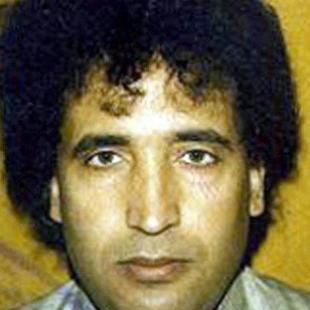
A storm erupted in international political circles after it was revealed that the only man convicted of the Lockerbie Bombing, Abdel baset Ali Mohmed Al Megrahi, has been repatriated to his home country. He is dying of Colonic Cancer, with reportedly weeks to live.
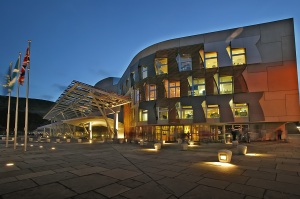
The Scottish Parliament
The political fall-out of this has been huge, with emergency sessions in the Scottish parliament, questions in the English parliament, and even statements made at Presidential level. Non-politicians such as the head of the FBI have even openly critisized the decision in the press, and have called for Scottish and British products to be banned.
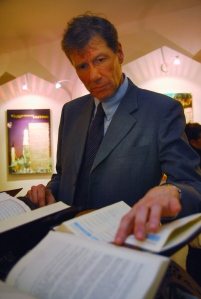
Kenny MacAskill
The Scottish Justice secretary, Kenny MacCaskill, faced questions in the Scottish Parliament and it remains to see whether he will be forced to step down.
So who was Al Megrahi?
Born in Tripoli in 1952, on April Fools day, he was educated in the United States and Cardiff. As an adult he had served as an intelligence officer in the Libyan Security Services. He was, ironically, the head of security for Libyan Arab Airlines for many years. Later he served as the director of the Centre for Strategic Studies.
His exact part in the bombing remains unclear, but he was clearly the most capable person of planning and implementing such an atrocity.
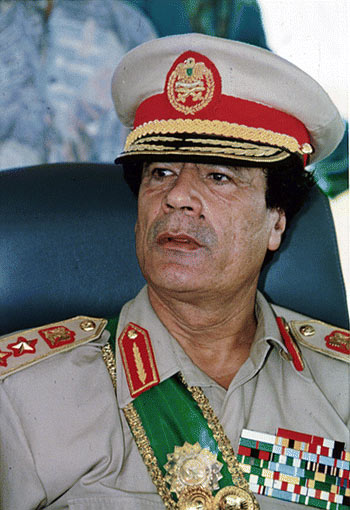
Muammar al-Gaddafi
The motive for the crimes were many. Throughout the mid-eighties the Libyan dictator, Muammer Al-Gaddafi, had struggled against the west for various reasons. He had come to power in a coup d’état in 1969. Once cemented into power he set about turning Libya into a base for anti-western activities. Any group, mainly but not exclusively Islamic, who claimed to be fighting the west, flocked to Libya for funding and training.
Soon he was training and directing terrorist operations against the west throughout the seventies and early eighties. It was thanks to him that many chilling names first hit the headlines. The PLO, Black September, Carlos the Jackal. The bombing of a West German nightclub led the Reagan administration to order large scale bombings of Libyan targets. 45 Libyan Military personnel were killed and 15 civilians. One of the civilians was Gaddafi’s adopted daughter, Hannah. Revenge was, no doubt sworn.
In the pre-suicide bomber age the targeting of a civilian airliner was done in a more chillingly calculated and subtle fashion. The best man to plan such a strike was doubtlessly al-Magrahi, the very man charged with preventing such a strike happening to the Libyan airline.
Pan Am flight 103, Heathrow – JFK airport, was chosen as a target. The date picked was just before Christmas, the most popular festival in the Western calendar. Flight 103 was based out of Heathrow airport, at the time understaffed with police and airport security. Sniffer dogs were partially trained and detector equipment went weeks without maintenance.
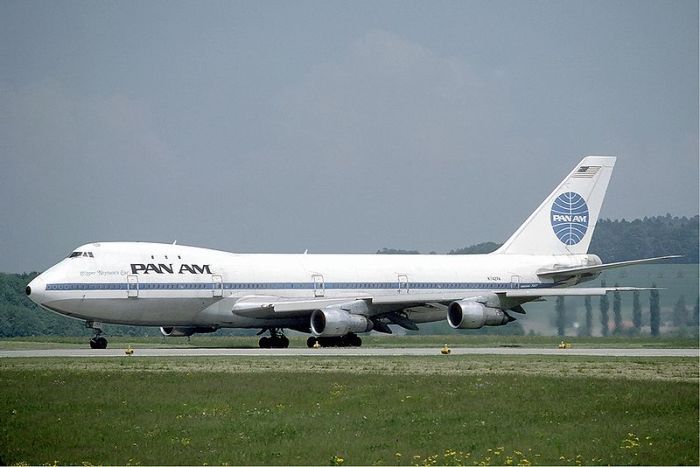
The Boeing 747-100
Flight 103 was a Boeing 747-100, commissioned in 1970 and named the Maiden of the Seas. She was old by aviation standards but apparently well maintained. Her crew of 16 were very experienced with the long haul route. She was carrying 243 passengers. 169 of these were American, as were 11 of the crew. Everybody was looking forward to spending a little quality time with their families. Gifts and toys were wrapped and stowed away in the hold. But so was something else.
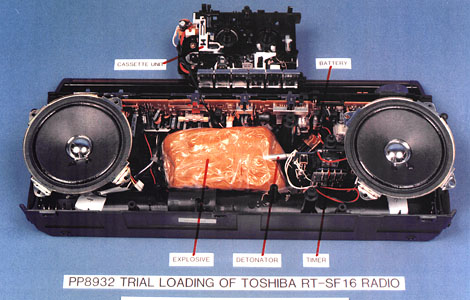
A model of the bomb used
In a Samsonite suitcase was a small cassette player packed with Semtex and a timer. It had then been wrapped in clothes recently purchased in Malta. The suitcase had already had a long journey. It had started out on an Air Malta flight, from there is had been on a flight to Frankfurt, then Frankfurt to London, and fatefully, London to New York.
The owner of the case had been Al-Megrahi, but he had failed to catch one of the connecting flights. His bags were checked and cleared at the small Maltese airport, possibly by an insider, and marked as clean. Once marked, they do not have to be rechecked at any stage in the journey. The die was cast.
Flight 103 took off from Heathrow airport at 18.25 GMT after a short delay. Captain McQuarrie flew north firstly, over the British midlands before entering Scottish airspace. From there we would have banked westwards out into the Atlantic Ocean. At 19.00 Flight 103 appeared on the screens of Prestwick air control, who hailed them. Captain MacQuarrie replied:
“Good evening Scottish, Clipper one zero three. We are at level three one zero.”
Then First Officer Wagner spoke:
“Clipper 103 requesting oceanic clearance.”
These were the last words heard from the aircraft.
The aircraft approached the Firth of Solway then disappeared from the screen. The controller, Alan Topp, who had, seconds ago spoke to Captain McQuarrie, rechecked his screen. The radar blip had disappeared and 103 was not responding. He hailed another aircraft, a KLM flight that was closer, to try and raise 103, but without success. Pan Am flight 103 was lost.
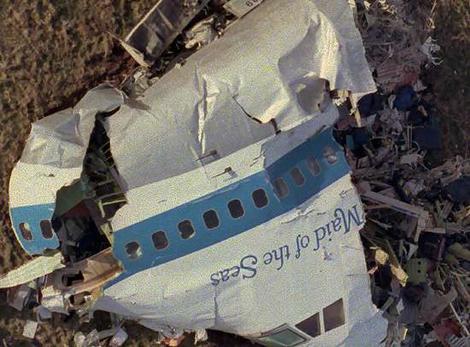
The bomb had exploded in the forward hold, just under the ‘P’ in the Pan Am logo. This essentially broke the ‘neck’ of the plane. The upwards blast killed the crew in an instant, and separated the nose and cockpit from the fuselage of the plane. They had not the time to send a distress signal or use their oxygen masks.
The remainder of the plane, now headless, was out of any control and started to disintegrate. The shockwaves from the blast reverberated around the cabin, causing the walls and the roof to separate. Passengers, still in their seats, were sucked out to their deaths. The sudden change in air pressure inflated the gases in their bodies to four times their normal size. The blast waves were even powerful enough to tear off clothes and turn unsecured objects such as hostess trolleys into lethal hazards. The fuselage lost height and fell, head first, on open ground. The passengers may have been alive, conscious even, on impact, as they showed few injuries from the explosion or depressurization.
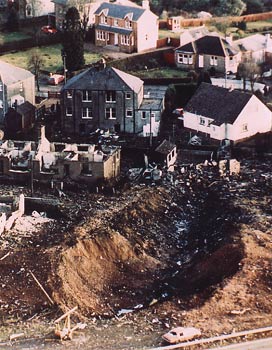
The ground zero of Lockerbie
The fuselage lost a wing in the blast, full of aviation fuel, that fell away separately. This landed squarely on 13 Sherwood Crescent, Lockerbie. Aviation fuel is highly concentrated and burns at an extremely high temperature. 11 people died when the house was incinerated. At number 15 Sherwood Crescent, Jack and Rosalind Somerville and their two small children were settling down for the evening when their house exploded. Nearby on the A74 road cars were scorched and drivers nearly blinded by the blast, causing cars to scatter over the road.
Confusion reigned. Some thought a nearby Nuclear power plant had exploded, others thought a fuel tanker on the A74 had crashed and ignited. A nearby geological survey station registered the impact as 1.6 on the Richter scale.
Father Paul Keegans had a lucky escape, he was on his way around to number 11 Sherwood Cresent when the wing impacted. The people he was due to visit were incinerated. Father Keegans house, number 1 Sherwood Crescent, was the only house in the street not damaged at all.
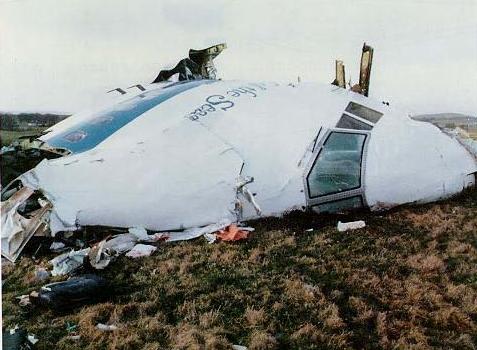
The crew were found still strapped in their chairs
The nose and cockpit were found in a field near to a church. Captain McQuarrie, his first officer, his mechanic and a flight attendant were inside. Only the flight attendant was found alive but she died before help could arrive. None were wearing oxygen masks. Captain McQuarrie’s hands were tightly wrapped around the control yoke. Even in death he had fought to save his passengers.
The Scottish emergency services swung into action. Police, fire brigade, medics, even soldiers were sent in to fight the fire and tend the wounded. In fact very few of the hospital beds that had been cleared to receive casualties were used. The fatalities were enormous and the mortuary was overwhelmed.
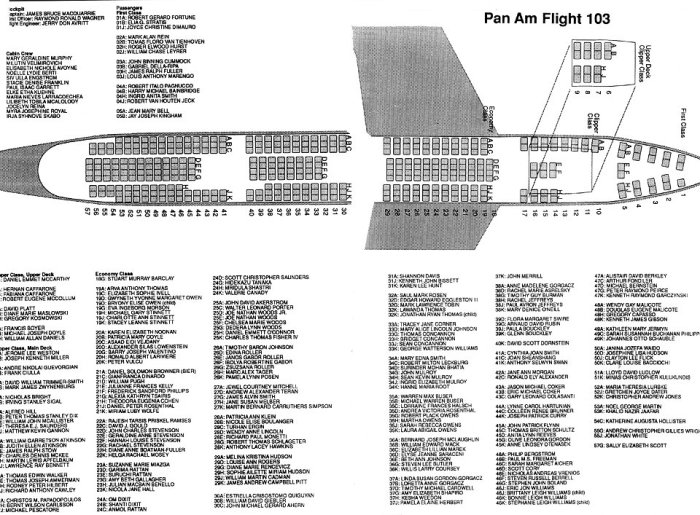
The flight manifest
But first every single body had to be located, photographed where it landed and then removed. All this took time and was hugely distressing for the Lockerbie residents who had to live, often for days, with bodies of passengers in their gardens. One was missing until the body fell out of a tree.
The department responsible for policing this crime was the Dumfrees and Galloway constabulary, the smallest in Scotland. They recruited officers from all over Scotland and specialists from the FBI to trace the evidence.
Had the plane not been delayed it would have exploded in the Atlantic Ocean, leaving no trace. But over land it left thousands of clues.
Over time the fuselage, and the case for the prosecution were pieced together. Fragments of a Samsonite suitcase were found and elements of a circuit board were found by a fingertip search. So were the pieces of a cassette player. In the same patch were fragments of clothing that, as it turned out, were purchased in Malta. To the FBI this looked familiar. A bomb had been found a few years previously in Germany in a cassette player. It had belonged to the Popular Front for the Liberation of Palestine, a sister organisation to the PLO. Both were largely funded by Libya.
The clothes were traced to a shop in Sliema, Malta. The proprietor, Tony Gauchi, who later appeared as a witness for the prosecution, testified that the man who bought them was of a swarthy appearance with a Libyan accent. He later identified Al-Megrahi from a photo in a magazine.
The trial took place, eventually, in the Hague, in 2001. The only two men ever being tried were Al-Magrahi and Lamin Khafila Fhirmah. Al-Magrahi was found guilty of Murder on 31 January 2001 but his alleged accomplice was aquitted.
The trial was never going to be an open and shut case, and there was little to directly link Al-Magrahi to the bomb. The prosecution witness, Tony Gauchi, was paid $2 million for his testimony. Mr Gauchi was described by a Scottish Advocate as being ‘not quite the full shilling’, though what this meant exactly has never been clarified.
Mr Al-Magrahi’s first appeal was quashed. He was in the process of applying for a second when he was diagnosed with Prostate Cancer. He dropped the second appeal and instead applied for compassionate release.
Mr Justice Kenny McAskill released him last week amid a storm of protest, not just from Scotland but also from America.
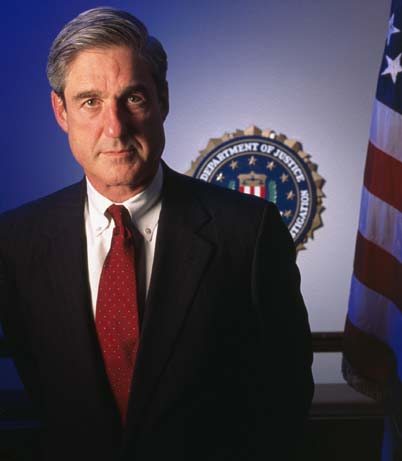
Robert Mueller, the Director of the FBI who assisted the Lockerbie case
The head of the FBI, Robert Mueller, who had been one of the FBI agents who helped the investigation shortly after the crash, wrote a furious letter to the Scottish Assembly accusing them of a miscarriage of justice. The American President, Barrack Obama, described the decision as highly objectionable.
The Prime Minister, Gordon Brown, himself a Scotsman, has remained silent on the issue, much to the anger of fellow politicians.
To understand Mr McAskill’s decision is hard. We all understand compassion but we also understand justice and accountability. The decision is being treated solely as a Scottish crime, ignoring the international and political issues at stake. Has he forgotten that 180 of the victims were American citizens? Or that the other victims came from 20 other countries? I doubt he consulted any of them or thought of the fallout that the case has generated.
So what will happen now? I suppose Mr McAskill will step down, and Mr Al-Magrahi will, inevitably, die. If he has a quiet funeral, fair enough. If he has a state funeral attended by Gaddafi or his ambitious son, it will case yet another storm.
Has there been some kind of a deal done with Libya? I am sure the details will come out over the next few weeks.
Mr Al-Magrahi was flown home on Gadaffi’s personal plane where he arrived to a large tribal reception. Some of them were waving Scottish flags, ironically.
The question on everybody’s lips is this: Should he have been released and flown home?
Yes I think he should have. Then when he got halfway there we should have blown the bastard out of the sky.
Two wrongs don’t make a right but they are one hell of a deterrent.



Thank you! I stumbled upon your site and write up quite by accident. I worked on a book on Pan Am 103 authored by Steve Emerson and Brian Duffy. It was very traumatic and depressing. I met the families of survivors here in the US. I was furious when he was released and angered that our President had a delayed response in criticizing it. I am not a public official but this man is a murderer. IF you look at the Boston College web site you can see a lovely memorial to the 22 students murdered at BC. Thanks for sharing this with those who may not have either remembered or been too young to remember it well. Thanks,
Susan
Susan
September 10, 2009 at 4:15 am
http://www.heraldscotland.com/news/politics/lockerbie-the-missing-pieces-1.1043526
– look… words fail me. ask yourself why one of the men who lost his daughter has maintained megrahi’s innocence all along. That alone was the only fact I needed to hear before I smelled a rat:
http://www.telegraph.co.uk/news/uknews/terrorism-in-the-uk/6069475/Father-still-seeking-Lockerbie-truth-after-20-years.html
watcher
July 25, 2010 at 8:44 am
He was innocent….americans manipulated the evidence, any detailed examination of the trial in 2001 shows this.
Considering the evidence gaddafi was almost certainly behind it but Megrahi was just a pawn used to settle the matter.
a
May 3, 2011 at 9:18 pm
Oh and there “was no storm of protest” in scotland, we have come to terms with the fact megrahi was innocent.
Finally, he would almost have certainly won his 2nd appeal, the evidence in favour began to lean heavily towards his innocence.
Oh and American Media always dictactes a need for blame. Hopefully with the unrest in libya we will soon find out.
a
May 3, 2011 at 9:22 pm
Looks like McAskill didn’t step down after all… If any Scottish prisoner was diagnosed with a terminal disease they would be able to appeal for Compassionate Release. We like to treat our prisoners like human beings here, which they are, no matter what they have done (and it seems like he didn’t do it anyway, but was the fall guy.) I don’t think America can criticise our justice system, when theirs is incerdibly flawed.
proudscot
May 9, 2012 at 2:07 pm
I can understand anger at the circumstances but that makes it all the more important that the wrongdoers are brought to justice. There is a lot of evidence that suggests the only man accused of Lockerbie was innocent all along
The London Upstart
February 12, 2013 at 9:45 pm